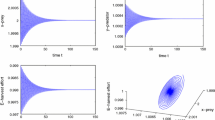Abstract
In this paper, a Filippov type model is proposed for the predator-prey system. The smooth subsystems of the proposed model admit regular and virtual equilibrium points and their dynamics is explored. The tangent points, boundary equilibrium and pseudo-equilibrium are obtained on discontinuity boundary. Equation of sliding motion is obtained using the Filippov’s convex method and sliding mode dynamics is discussed. It has been shown that the Filippov system admits pseudo-equilibrium, only if virtual equilibrium of two subsystems coexist. The value of threshold parameter is computed for which tangent point and boundary equilibrium collide. The two parameter bifurcation diagram is drawn to show the existence of regular and virtual equilibrium points in different regions. The existence of boundary equilibrium bifurcation is investigated through numerical simulation, as value of threshold parameter varies.







Similar content being viewed by others
References
Ajraldi, V., Venturino, E.: Stabilizing effect of prey competition for predators exhibiting switching feeding behavior. WSEAS Trans. Biol. Biomed. 5, 65–74 (2008)
Bernardo, M., Budd, C.J., Champneys, A.R., Kowalczyk, P.: Piecewise-smooth Dynamical Systems: Theory and Applications. Applied Mathematical Sciences, vol. 163. Springer-Verlag, London (2008)
Cantrell, R.S., Cosner, C.: On the dynamics of predator-prey models with the Beddington-DeAngelis functional response. J. Math. Anal. Appl. 257(1), 206–222 (2001)
Chen, X., Huang, L.: A Filippov system describing the effect of prey refuge use on a ratio-dependent predator-prey model. J. Math. Anal. Appl. 428(2), 817–837 (2015)
Danca, M.F.: On the uniqueness of solutions to a class of discontinuous dynamical systems. Nonlinear Anal. Real World Appl. 11(3), 1402–1412 (2010)
Dercole, F., Gragnani, A., Rinaldi, S.: Bifurcation analysis of piecewise smooth ecological models. Theor. Popul. Biol. 72(2), 197–213 (2007)
Dieci, L., Lopez, L.: Sliding motion in Filippov differential systems: theoretical results and a computational approach. SIAM J. Numer. Anal. 47(3), 2023–2051 (2009)
Filippov, A.: Differential Equations with Discontinuous Right-Hand Sides. Kluwer Academic, Dordrecht (1988)
Gakkhar, S., Naji, R.K.: Order and chaos in a food web consisting of a predator and two independent preys. Commun. Nonlinear Sci. Numer. Simul. 10(2), 105–120 (2005)
Huang, Y., Chen, F., Zhong, L.: Stability analysis of a prey-predator model with Holling type III response function incorporating a prey refuge. Appl. Math. Comput. 182(1), 672–683 (2006)
Khan, Q.J.A., Balakrishnan, E., Wake, G.C.: Analysis of a predator-prey system with predator switching. Bull. Math. Biol. 66(1), 109–123 (2004)
Kuznetsov, Y.A., Rinaldi, S., Gragnani, A.: One-parameter bifurcations in planar Filippov systems. Int. J. Bifurc. Chaos 13(8), 2157–2188 (2003)
Leine, R.I., Nijmeijer, H.: Dynamics and bifurcations of non-smooth mechanical systems. Lecture Notes in Applied and Computational Mechanics, vol. 18. Springer-Verlag, Berlin (2004)
Lv, Y., Yuan, R., Pei, Y.: Two types of predator-prey models with harvesting: non-smooth and non-continuous. J. Comput. Appl. Math. 250, 122–142 (2013)
Naji, R.K., Shalan, R.N.: The dynamics of holling type IV prey predator model with intra-specific competition. Iraqi J. Sci. 54(2), 386–396 (2013)
Perko, L.: Differential Equations and Dynamical Systems, vol. 7. Springer, New York (1991)
Seo, G., DeAngelis, D.L.: A predator-prey model with a Holling type I functional response including a predator mutual interference. J. Nonlinear Sci. 21(6), 811–833 (2011)
Skalski, G.T., Gilliam, J.F.: Functional responses with predator interference: viable alternatives to the Holling type II model. Ecology 82(11), 3083–3092 (2001)
Tang, S., Tang, G., Qin, W.: Codimension-1 sliding bifurcations of a Filippov pest growth model with threshold policy. Int. J. Bifurc. Chaos 24(10), 1450122 (2014)
Tripathi, J.P., Abbas, S., Thakur, M.: Dynamical analysis of a prey-predator model with Beddington-DeAngelis type function response incorporating a prey refuge. Nonlinear Dyn. 80(1–2), 177–196 (2015)
Utkin, V.I.: Sliding modes in control and optimization, vol. 116. Springer-Verlag, Berlin (1992)
Wang, A., Xiao, Y.: Sliding bifurcation and global dynamics of a Filippov epidemic model with vaccination. Int. J. Bifurc. Chaos 23(8), 1350144 (2013)
Yang, J., Tang, S., Cheke, R.A.: Global stability and sliding bifurcations of a non-smooth Gause predator-prey system. Appl. Math. Comput. 224, 9–20 (2013)
Zhang, X., Tang, S.: Existence of multiple sliding segments and bifurcation analysis of Filippov prey-predator model. Appl. Math. Comput. 239, 265–284 (2014)
Zhang, X., Tang, S.: Filippov ratio-dependent prey-predator model with threshold policy control. Abstr. Appl. Anal. 2013, 11 (2013)
Acknowledgments
We are thankful to reviewers for their valuable comments and suggestions. The first author (K. Gupta) would like to thank “University Grants Commission (UGC)” for providing Senior Research Fellowship through Grant No. 6405-11-044.
Author information
Authors and Affiliations
Corresponding author
Rights and permissions
About this article
Cite this article
Gupta, K., Gakkhar, S. The Filippov Approach for Predator-Prey System Involving Mixed Type of Functional Responses. Differ Equ Dyn Syst 28, 273–293 (2020). https://doi.org/10.1007/s12591-016-0322-x
Published:
Issue Date:
DOI: https://doi.org/10.1007/s12591-016-0322-x




